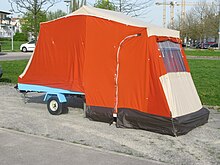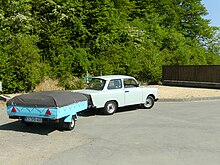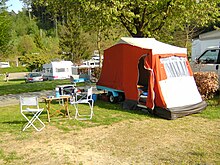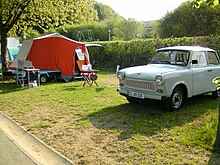Rhön Universal
The Rhön Universal is a light, unbraked load tent trailer (LZA) that the state-owned company Bergwerksmaschinen Dietlas / Rhön manufactured in around 1000 units from September 1988 to around 1990 as part of the so-called consumer goods production.
General
The type designation of the trailer is HP40.01.84 / 50. Three color variants are known: white car body with red polyester cover , white car body with blue polyester cover and blue car body with white polyester cover. The publicly owned company also produced the tent structure in different colors, always using beige and orange panels, which were, however, combined differently. In addition, the mud flap made of rubberized material at the bottom of the rear part of the tent was initially blue, but later dark brown.
use
The Rhön Universal can be used as a lightweight camping trailer thanks to its tent construction integrated in the trailer lid ; without the lid, it serves as a lightweight trailer for occasional transport tasks. With an empty weight of 130 kilograms without a lid and 200 kilograms as a camping trailer, the Rhön Universal could also be pulled by the Trabant 601 , which with the heavier and better equipped Camptourist folding trailers reached its limits, at least on longer mountain stages. Outside of the period of use, the Rhön Universal can be set up on edge, for example on a garage wall, using two supports that are inserted into the frame.
Chassis and body
The Rhön Universal has a 195 × 145 × 30 centimeter, welded car body made of sheet steel with a tailgate attached to the sheet metal floor. The car body rests on an unbraked chassis with a V drawbar and two eight-inch steel wheels with 4.00-8 4 PR 55 tires from Pneumant that are individually suspended from trailing arms . The suspension of the two trailing arms is taken care of by two rubber cylinders of different diameters that are subjected to compression. This enabled the manufacturer to achieve progressive suspension behavior so that the Rhön Universal does not tend to jump too much when unloaded and absorbs shocks well when loaded, for example through potholes. The permissible total weight of the trailer, the chassis and the axle is 400 kilograms, the permissible drawbar support load is 50 kilograms. The KK82 model with automatic locking from VEB Fahrzeugwerk Waltershausen is used as a trailer coupling. On the drawbar, a support rod is used in a clamping device instead of a front wheel. Together with the two foldable supports on the rear part of the chassis, the Rhön Universal stands securely even when it is uncoupled. The two rear supports each hold a spiral spring horizontally on the frame while driving. In the event that this spring breaks, an artificial leather strap prevents the folding support from falling onto the road. VEB Fahrzeugelektrik Ruhla contributed the two three-chamber lights and the two license plate lights , as did the seven-pin plug for connecting to the electrics of the towing vehicle. There is a spare wheel on the drawbar that is secured against theft with a lock.
Tent construction
When camping, the Rhön Universal can be used as a simple tent caravan . For this purpose, the trailer has a fixed cover made of polyester, which is attached to the tailgate of the body. Two locks on the front of the car body keep the lid closed while driving. A circumferential rubber seal on the inside of the lid prevents moisture from getting inside the car. A tubular steel rail on the lid serves as a luggage holder while driving. The included tarpaulin protects the luggage from the weather and wind. When the tent is set up, the inside of the cover that is folded back becomes the tent floor and the railing becomes the base of the cover. The tent fabric and poles are attached to the car body and cover. The tent fabric consists of heavy, resistant, impregnated cotton fabric, the frame of white painted tubular steel. The tent entrance is in the back half of the left tent wall and can be opened and closed with a zipper. Light enters through a coverable window film with mosquito gauze on the rear tent wall. The floor in the inside of the folded lid is covered with synthetic leather. The sleeping area for two people is on the loading area of the car body and corresponds to its dimensions. As an extra, an inner cabin made of light, undyed cotton fabric with a foil floor was available, which makes the bedroom more homely and which can be closed with a zipper and thus offers additional protection against drafts or insects. The four standard, around four centimeters thick mattress parts can be placed in the sleeping cabin and can stay there even in the folded tent trailer. The optional tent cabin is tied to the poles with cotton loops and folds up and down when the tent is set up and taken down. On the left side of the tent in the direction of travel, seven small loops are sewn onto the roof, to which a sun sail can be attached. Presumably, such a sun sail was no longer offered by the manufacturer. A planned kitchen box to be attached to the drawbar was also no longer in production.
Set up and fold up
The Rhön Universal load tent trailer can be set up in around two minutes. The following work steps are required for this: 1. Uncouple the trailer from the towing vehicle and set it up on a level surface. 2. Loosen both folding supports under the rear from the safety loops and swing them against the spring force over the dead center to the ground. 3. Align the trailer horizontally with the support on the drawbar so that it stands securely. 4. Open both locks on the front wall of the car body. 5. Put the rubber protector on the railing to protect it against scratching. 6. The lid is best opened by two people or carefully by yourself until the rail of the lid rests on the floor behind the trailer. The tent will set up automatically. 7. Tension the tent in the area of the car body with the rubber cord on its toggles. 8. Stretch the rubber mud flaps of the rear part of the tent over the edge of the lid. 9. Fix the tent structure with pegs depending on the location and weather conditions.
The dismantling is done in reverse order, however, a few points must be observed: When closing the lid, make sure that both pins on the tailgate properly engage in the corresponding openings at the end of the side walls and that the tent fabric does not get in between, otherwise there are holes or Fear of tears in the cloth. The tent material must also be carefully folded inwards when closing it further. Ideally, two people close the lid. A single person places the lid on the wooden support provided, sorts the fabric through the remaining gap and then closes the lid completely. It is absolutely necessary to lock the two locks on the front of the lid with the key, otherwise the locks can snap open again by themselves. Then the lid could open due to the airflow.
Use as a cargo trailer
Including the tent and polyester lid, the Rhön Universal has a net weight of 200 kilograms, so theoretically it can still hold 200 kilograms of luggage. This can be found on the lying surface in the car body or securely lashed to the railing on the polyester lid.
In order to be able to use the Rhön Universal as a pure cargo trailer, the tent must first be set up. Then loosen the screws for the tent poles on the trailer, and then unscrew the polyester cover from the tailgate. The tent and poles remain in the lid and can be covered with the tarpaulin as protection against dust and dirt. The trailer itself then offers a load of 270 kg, relieved by the camping equipment weighing around 70 kilograms.
The Rhön Universal today
The political turning point in the GDR and the economic changes that followed it in East Germany meant that production of the Rhön Universal was stopped in 1990 after only around two years of construction and around 1,000 copies. According to the experience of previous and present users, the quality of the load tent trailer, especially with regard to the paintwork and corrosion protection, should have fluctuated widely. This fact and the fact that the trailers were used and cared for differently over the years meant that the condition of today's specimens varies greatly. There are heavily corroded trailers with worn out tents as well as almost new or restored ones. The longitudinal overlap of the two floor panels, on which severe corrosion often occurs, has proven to be the weak point . The transition from the front wall to the floor of the car body is also at risk from rust. The same applies to the area above the wheel arches. The cover made of polyester sometimes shows cracks as a result of excessive punctual loads, especially in those areas where it is supported on the railing during camping. The gelcoat layer of the lid can show small cracks or larger flakes as a result of years of UV radiation . The railing of the cover made of painted steel tube often shows larger rust spots, which, however, can usually be removed due to the sufficient wall thickness of the tubes. The tent fabric is faded in many of the specimens. If the tent was folded up wet and not set up again to dry within a few days, mold stains or even rotted areas in the fabric are often the result. Repairing the Rhön Universal will make it easier to assemble and make extensive use of common parts from GDR trailer construction. Original parts such as trailer hitch, rims, tires, wheel bearings, spring rubbers, taillights, seven-pin plugs and locks can still be purchased at least online.
The polyester lid can be repaired with fiberglass mats, synthetic resin and polyester putty. As a spare part, however, it is as good as no longer available as new or used. Finding a replacement tent is just as difficult. If you can't find one on the Internet, the only alternative to partial repairs is to reproduce using the worn original.
Sources and literature
- Schäfer, Dr. M./Homann, S., Der Deutsche Straßenverkehr 9/1988, p. 25
- Schäfer, Dr. M./Homann, S., KFT motor vehicle technology 9/1988, p. 281f
- Operating instructions 01/40/84/50 Load tent trailer Rhön Universal




